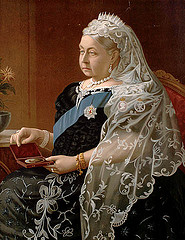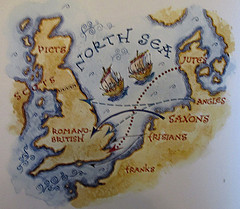Eighty nine year old Queen Elizabeth and her husband have arrived in Germany. The German news site, DW, wrote,
“… the royal couple will be paying their fifth state visit to the country of the Queen’s ancestors from June 23-26.”
The Queen’s connection to some in Germany is easily traced.
 In 1840 Queen Victoria, monarch of the British Empire, married a cousin, Prince Albert of Saxe-Coburg and Saxe-Gotha. Queen Victoria and her husband, Prince Albert, had nine children.
In 1840 Queen Victoria, monarch of the British Empire, married a cousin, Prince Albert of Saxe-Coburg and Saxe-Gotha. Queen Victoria and her husband, Prince Albert, had nine children.
Biography.com states that,
“One of the major factors that helped Britain avoid European entanglements was the marriage of Victoria’s children: either directly or by marriage, she was related to the royal houses of nearly every major European power … .”
Queen Elizabeth II and Prince Philip are cousins as well. He is the firstborn son but youngest child of Prince Andrew of Greece and Denmark. The two are great great grandchildren of Queen Victoria and Prince Albert.
Queen Victoria died on January 22, 1901, at age 81. The Biography site noted,
“Her son and successor King Edward VII and her eldest grandson Emperor William II (or Wilhelm II) of Germany were both at her bedside.”
Saxons
A long history exists between German and English ordinary citizens too.
 According to the BBC, after the last Roman soldiers left Britain, the Anglo-Saxons migrated in ships across the North Sea, in the 5th century. They left predominately from the area now defined on maps as north Germany, Denmark, and north Holland.
According to the BBC, after the last Roman soldiers left Britain, the Anglo-Saxons migrated in ships across the North Sea, in the 5th century. They left predominately from the area now defined on maps as north Germany, Denmark, and north Holland.
Before that, the Saxons and other related people had traveled from further east — from the Caucasus area, in and near Russia, after Babylon conquered the Assyrian Empire.
Royal Connection
The word Saxe is actually French for Saxony, according to Merriam-Webster’s dictionary (Sachsen is the German equivalent).
Interestingly, the Saxe-Coburg Heritage website confirms that the region of Saxe-Coburg and Saxe-Gotha in central Germany — Prince Albert’s birthplace and childhood home — were considered “Saxon duchies”. However, to date, a number of historians apparently regard only Old Saxony in the northwest as the former home of the Saxons who left Germany beginning in the 5th century.
Family Feuds
Less than two decades after Queen Victoria’s death, her grandsons the British King George V and German Emperor Wilhelm II, along with other cousins, would be fighting each other during WWI.
Progeny fighting is not a more modern phenomenon.
Anciently, during the time of King David’s grandson, the 10 northern tribes of Israel split from Judah (the tribes of Judah, Benjamin, and Levi). It didn’t take long for Jacob’s offspring, the two nations of Judah and Israel, to begin fighting each other.
Lessons for Us
In anticipation of the visit, DW broadcast a documentary titled “A Right Royal Welcome”. Queen Elizabeth and Prince Philip are being warmly welcomed back. Europe and the English-speaking world are delighted.
Yet, we must not forget the decades following Queen Victoria’s death. Ancient and modern history should remind us just how swiftly and dramatically circumstances, relationships, and borders can change while human proclivities stay the same.
Photo credits: Library and Archives Canada, C-008133; and Diego Sideburns – CC BY License
View the Biography site here
Read about Victoria’s children here
See the Saxe-Coburg Heritage site here
Prior European News